A Novel Method for Achieving Precision and Reproducibility in a 1.8 GHz Radiofrequency Exposure System That Modulates Intracellular ROS as a Function of Signal Amplitude in Human Cell Cultures
Abstract
1. Introduction
2. Materials and Methods
2.1. Cell Cultures, Growth, and Exposure Conditions
2.2. Quantitative RT-PCR Analysis of Altered Gene Expression
2.3. Statistical Analysis
2.4. The RF Exposure System
2.5. Detailed Technical Description of the RF Exposure Device
2.5.1. The Geometric Aspects
2.5.2. The Thermal Aspects
2.5.3. The Electromagnetic Aspects
2.5.4. The Simulated Antenna
2.5.5. The Actual Antenna
2.5.6. The RF Exposure System (Simulations)
2.5.7. RF Exposure of the Petri Dish and the Probe Holders (Measurements)
2.5.8. Preliminary Electromagnetic Measurements
3. Results
3.1. Experimental Design for RF Exposure
3.2. Signal Amplitude-Dependent Gene Expression Is Triggered by RF Exposure
4. Discussion
4.1. Cellular Response to RF Does Not Involve Thermal Effects
4.2. Human Cells Show a Physiological Response to RF Exposure at Amplitudes Below Current Safety Standards
4.3. RF Exposure Is Linked to Intracellular ROS and ROS Signaling Pathways
4.4. Importance of Hormesis in Determining RF Safety Limits and Toxicology
5. Concluding Remarks and Future Perspectives
Supplementary Materials
Author Contributions
Funding
Institutional Review Board Statement
Informed Consent Statement
Data Availability Statement
Acknowledgments
Conflicts of Interest
References
- Ijaz, S.; Dore, J.-F.; Driessen, S.; Whaley, P. Special Issue: WHO Assessment of Health Effects of Exposure to Radiofrequency Electromagnetic Fields: Systematic Reviews. Environ. Int. 2024, 191. Available online: https://www.sciencedirect.com/special-issue/109J1SL7CXT (accessed on 1 January 2024).
- Foster, K.R.; Ziskin, M.C.; Balzano, Q. Bit-Babik Modeling Tissue Heating From Exposure to Radiofrequency Energy and Relevance of Tissue Heating to Exposure Limits: Heating Factor. Health Phys. 2018, 115, 295–307. [Google Scholar] [CrossRef] [PubMed]
- Miyakoshi, J. Cellular and molecular responses to radio-frequency electromagnetic fields. Proc. IEEE. Inst. Electr. Electron. Eng. 2013, 101, 1494–1502. [Google Scholar] [CrossRef]
- Nowak-Terpiłowska, A.; Górski, R.; Marszałek, M.; Wosiński, S.; Przesmycki, R.; Bugaj, M.; Nowosielski, L.; Baranowski, M.; Zeyland, J. Effects of 2.4 GHz radiofrequency electromagnetic field (RF-EMF) on glioblastoma cells (U-118 MG). Ann. Agric. Environ. Med. 2023, 30, 763–772. [Google Scholar] [CrossRef] [PubMed]
- Choi, J.; Min, K.; Jeon, S.; Kim, N.; Pack, J.-K.; Song, K. Continuous Exposure to 1.7 GHz LTE Electromagnetic Fields Increases Intracellular Reactive Oxygen Species to Decrease Human Cell Proliferation and Induce Senescence. Sci. Rep. 2020, 10, 9238. [Google Scholar] [CrossRef]
- Xie, W.; Xu, R.; Fan, C.; Yang, C.; Chen, H.; Cao, Y. 900 MHz Radiofrequency Field Induces Mitochondrial Unfolded Protein Response in Mouse Bone Marrow Stem Cells. Front. Public Health 2021, 9, 724239. Available online: https://www.frontiersin.org/journals/public-health/articles/10.3389/fpubh.2021.724239 (accessed on 1 January 2024). [CrossRef]
- Santini, S.J.; Cordone, V.; Falone, S.; Mijit, M.; Tatone, C.; Amicarelli, F.; Di Emidio, G. Role of Mitochondria in the Oxidative Stress Induced by Electromagnetic Fields: Focus on Reproductive Systems. Oxidative Med. Cell. Longev. 2018, 2018, 5076271. [Google Scholar] [CrossRef]
- Yakymenko, I.; Tsybulin, O.; Sidorik, E.; Henshel, D.; Kyrylenko, O.; Kyrylenko, S. Oxidative mechanisms of biological activity of low-intensity radiofrequency radiation. Electromagn. Biol. Med. 2015, 35, 186–202. [Google Scholar] [CrossRef]
- Pooam, M.; Jourdan, N.; Aguida, B.; Dahon, C.; Baouz, S.; Terry, C.; Raad, H.; Ahmad, M. Exposure to 1.8 GHz radiofrequency field modulates ROS in human HEK293 cells as a function of signal amplitude. Commun. Integr. Biol. 2022, 15, 54–66. [Google Scholar] [CrossRef]
- Meyer, F.; Bitsch, A.; Forman, H.J.; Fragoulis, A.; Ghezzi, P.; Henschenmacher, B.; Kellner, R.; Kuhne, J.; Ludwig, T.; Sachno, D.; et al. The effects of radiofrequency electromagnetic field exposure on biomarkers of oxidative stress in vivo and in vitro: A systematic review of experimental studies. Environ. Int. 2024, 194, 108940. [Google Scholar] [CrossRef]
- Hansen, J.W.; Swartz, E.M.; Cleveland, J.D.; Asif, S.M.; Brooks, B.; Braaten, B.D.; Ewert, D.L. A Systematic Review of In Vitro and In Vivo Radio Frequency Exposure Methods. IEEE Rev. Biomed. Eng. 2020, 13, 340–351. [Google Scholar] [CrossRef] [PubMed]
- Komnatnov, M.; Gazizov, T. Environmental shielded TEM chamber for biomedical testing. In Proceedings of the 2014 IEEE MTT-S International Microwave Workshop Series on RF and Wireless Technologies for Biomedical and Healthcare Applications (IMWS-Bio2014), London, UK, 8–10 December 2024; pp. 1–3. [Google Scholar]
- Massaro, L.; De Sanctis, S.; Franchini, V.; Regalbuto, E.; Alfano, G.; Focaccetti, C.; Benvenuto, M.; Cifaldi, L.; Sgura, A.; Lista, F. Study of genotoxic and cytotoxic effects induced in human fibroblasts by exposure to pulsed and continuous 1.6 GHz radiofrequency. Front. Public Health 2024, 12, 1419525. [Google Scholar] [CrossRef]
- Jain, S.; Vojisaveljevic, V.; Pirogova, E. Low power microwaves at 1.8 GHz and 2.1 GHz induce chages in Catalase enzyme kinetics. In Proceedings of the 2016 IEEE MTT-S International Microwave and RF Conference (IMaRC), New Delhi, India, 5–9 December 2016; pp. 1–4. [Google Scholar]
- Peng, C.; Dan, L.; Jia-Hui, Z. The Study of A Cellular Electromagnetic Irradiation Device Using Taper Coaxial Line. In Proceedings of the 2023 IEEE 11th International Conference on Information, Communication and Networks, Xi’an, China, 17–20 August 2023; pp. 524–527. [Google Scholar]
- Ye, D.; Cutter, G.; Caldwell, T.P.; Harcum, S.W.; Wang, P. A Systematic Method to Explore Radio-Frequency Non-Thermal Effect on the Growth of Saccharomyces cerevisiae. IEEE J. Electromagn. RF Microw. Med. Biol. 2021, 6, 52–60. [Google Scholar] [CrossRef]
- Anderson, V.; Wood, A.W.; Joyner, K.H. Development of a new in vitro RF exposure device for confocal microscopy imaging during concurrent 900 MHz RF exposure. In Proceedings of the 2nd International Conference on Bioelectromagnetism (Cat. No. 98TH8269), Melbourne, Australia, 15–18 February 1998; pp. 81–82. [Google Scholar]
- Paffi, A.; Apollonio, F.; Liberti, M.; Grandinetti, L.; Chicarella, S.; d’Inzeo, G. A new wire patch cell for the exposure of cell cultures to electromagnetic fields at 2.45 GHz: Design and numerical characterization. In Proceedings of the 2009 European Microwave Conference (EuMC), Rome, Italy, 29 September–1 October 2009; pp. 870–873. [Google Scholar]
- Kuster, N.; Schönborn, F. Recommended minimal requirements and development guidelines for exposure setups of bio-experiments addressing the health risk concern of wireless communications. Bioelectromagnetics 2000, 21, 508–514. [Google Scholar] [CrossRef] [PubMed]
- Porcher, A.; Wilmot, N.; Bonnet, P.; Procaccio, V.; Vian, A. Changes in Gene Expression After Exposing Arabidopsis thaliana Plants to Nanosecond High Amplitude Electromagnetic Field Pulses. Bioelectromagnetics 2024, 45, 4–15. [Google Scholar] [CrossRef]
- International Commission on Non-Ionizing Radiation Protection. Guidelines for limiting exposure to electromagnetic fields (100 kHz to 300 GHz). Health Phys. 2020, 118, 483–524. Available online: https://www.icnirp.org/cms/upload/publications/ICNIRPrfgdl2020.pdf (accessed on 24 February 2025). [CrossRef]
- Nitti, M.; Marengo, B.; Furfaro, A.L.; Pronzato, M.A.; Marinari, U.M.; Domenicotti, C.; Traverso, N. Hormesis and Oxidative Distress: Pathophysiology of Reactive Oxygen Species and the Open Question of Antioxidant Modulation and Supplementation. Antioxidants 2022, 11, 1613. [Google Scholar] [CrossRef] [PubMed] [PubMed Central]
- Schuermann, D.; Mevissen, M. Manmade Electromagnetic Fields and Oxidative Stress—Biological Effects and Consequences for Health. Int. J. Mol. Sci. 2021, 22, 3772. [Google Scholar] [CrossRef]
- Calabrese, E.J. Biphasic dose responses in biology, toxicology and medicine: Accounting for their generalizability and quantitative features. Environ. Pollut. 2013, 182, 452–460. [Google Scholar] [CrossRef]
- Jodynis-Liebert, J.; Kujawska, M. Biphasic Dose-Response Induced by Phytochemicals: Experimental Evidence. J. Clin. Med. 2020, 9, 718. [Google Scholar] [CrossRef]
- Paula Ludovico William, C. Burhans, Reactive oxygen species, ageing and the hormesis police. FEMS Yeast Res. 2014, 14, 33–39. [Google Scholar] [CrossRef]
- Cheng, Y.W.; Liu, J.; Finkel, T. Mitohormesis. Cell Metab. 2023, 35, 1872–1886. [Google Scholar] [CrossRef] [PubMed]
- Wan, Y.; Liu, J.; Mai, Y.; Hong, Y.; Jia, Z.; Tian, G.; Liu, Y.; Liang, H.; Liu, J. Current advances and future trends of hormesis in disease. npj Aging 2024, 10, 26. [Google Scholar] [CrossRef]
- Thoradit, T.; Chabi, M.; Aguida, B.; Baouz, S.; Stierle, V.; Pooam, M.; Tousaints, S.; Ahmad, M. Hypersensitivity to man-made electromagnetic fields (EHS) correlates with immune responsivity to oxidative stress: A case report. Commun. Integr. Biol. 2024, 17, 2384874. [Google Scholar] [CrossRef] [PubMed]
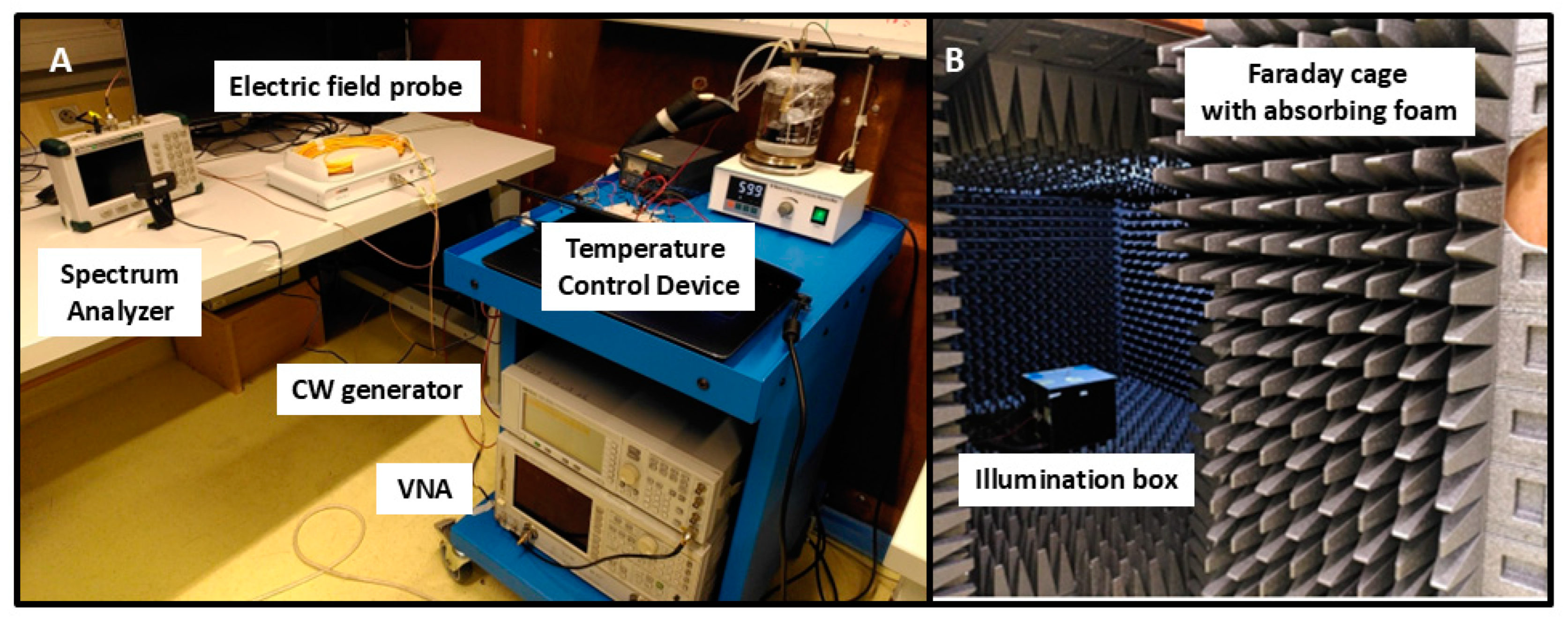
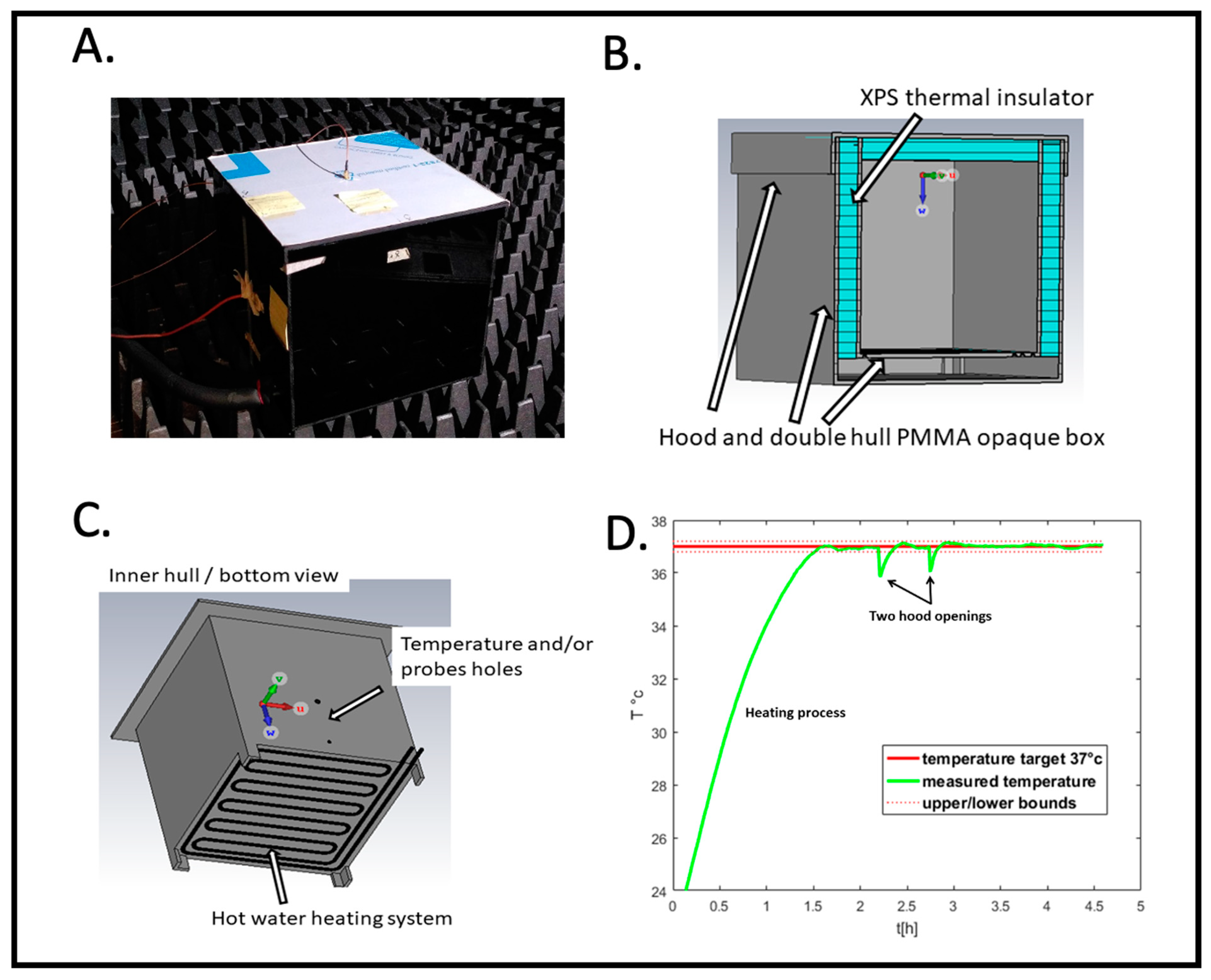

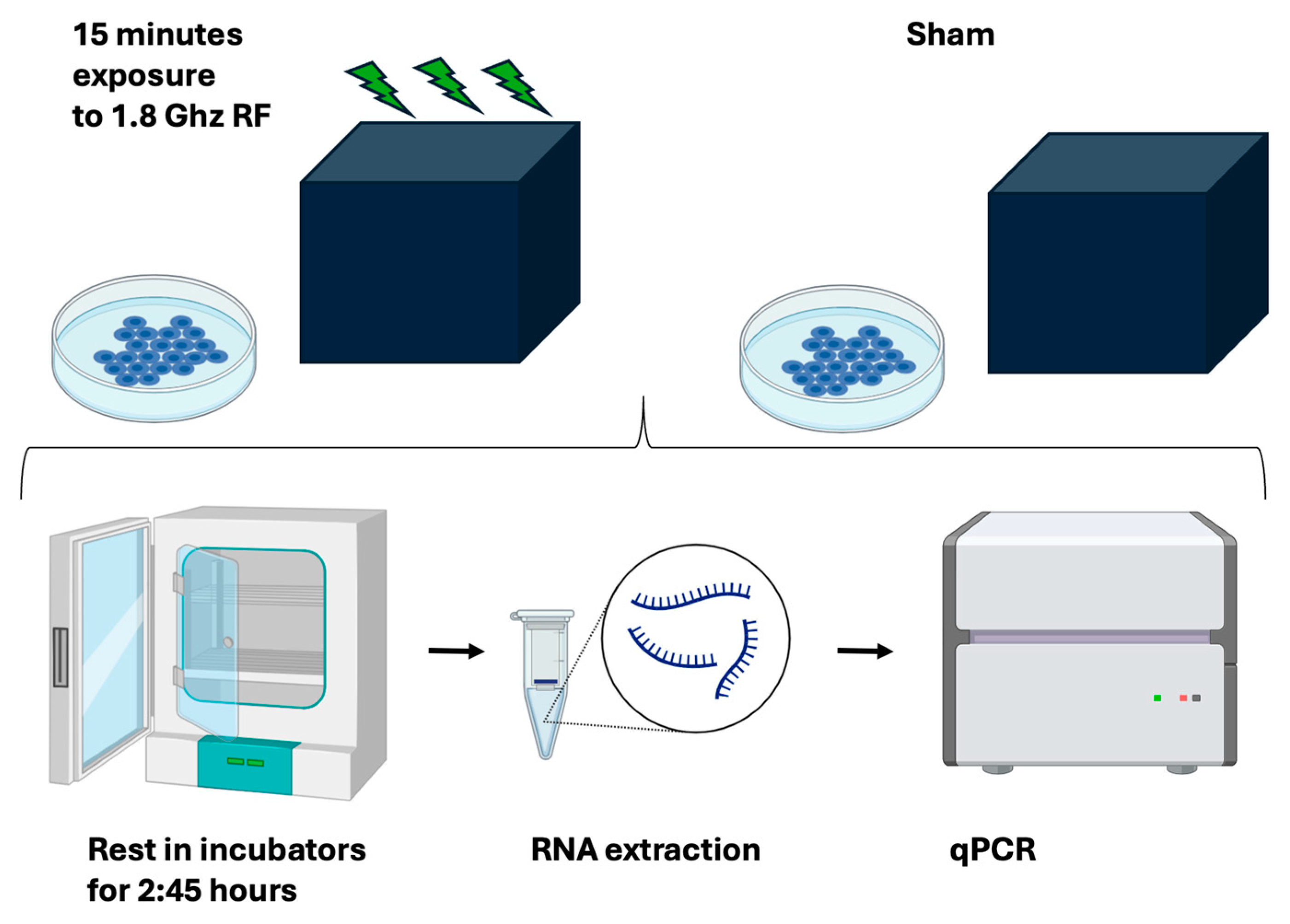
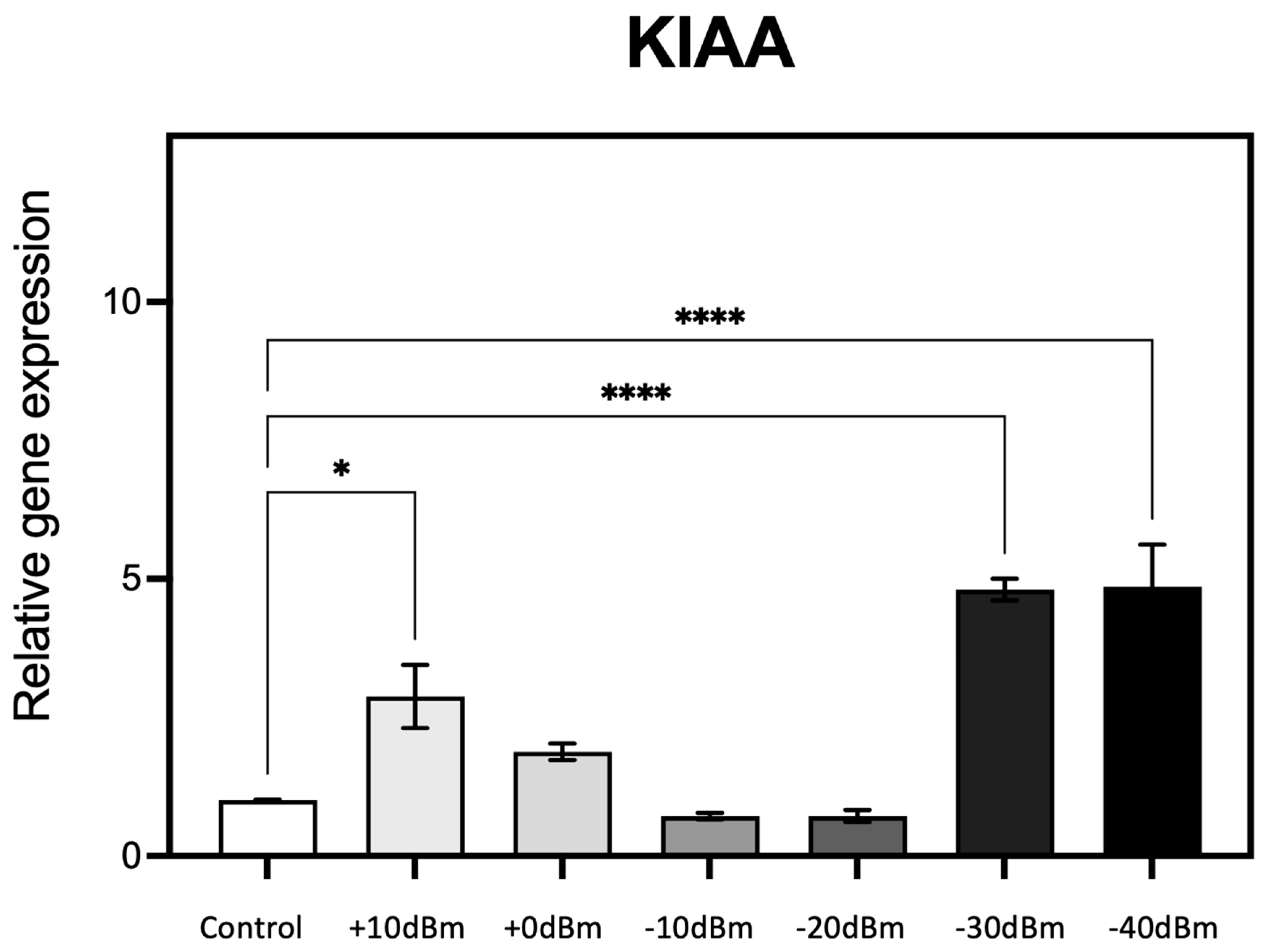
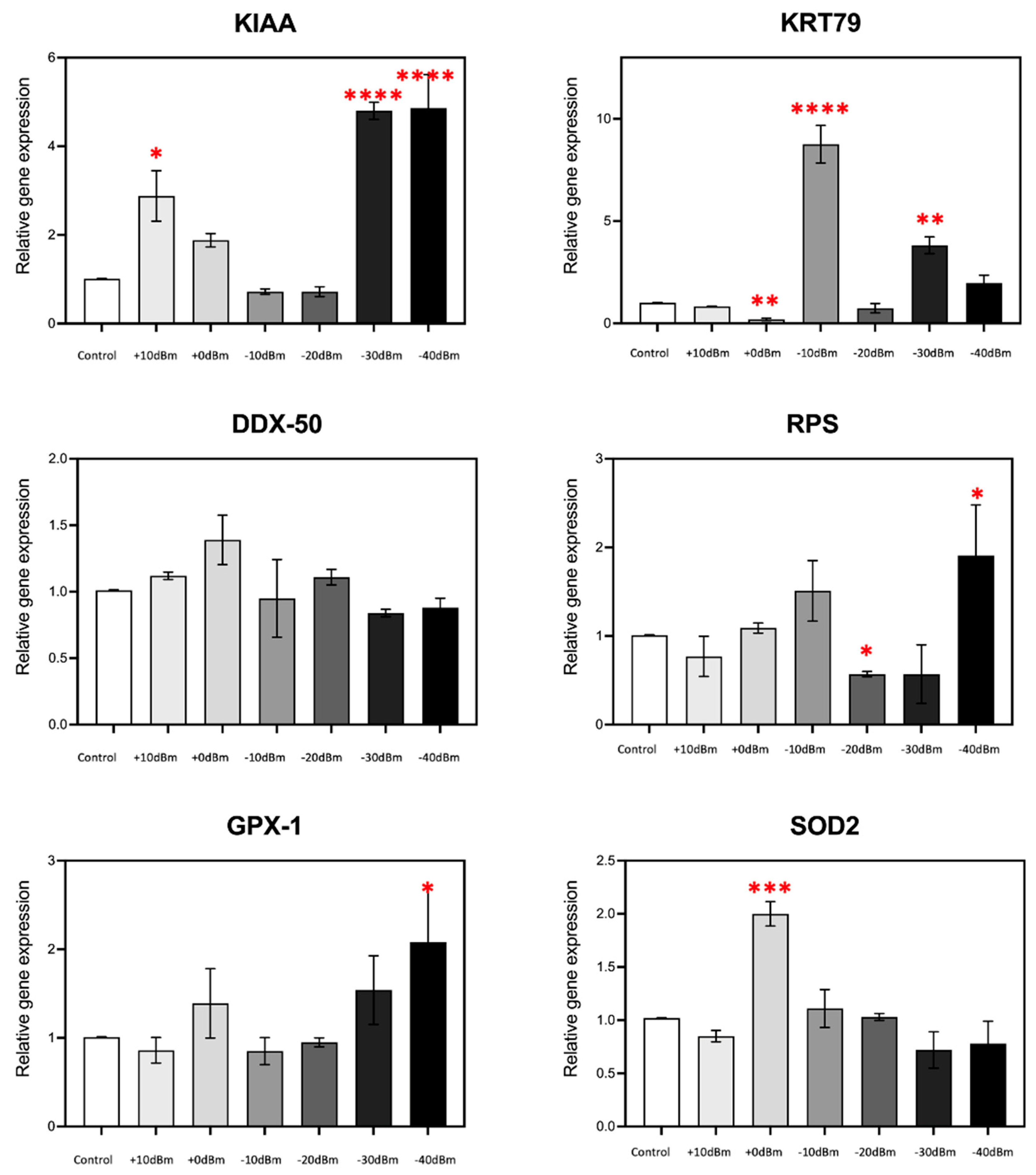
| Species | Genes | Forward Primer 5′-3′ | Reverse Primer 5′-3′ |
|---|---|---|---|
| Human | KIAA1211 | AGCTGGCTGTTAAGCCAAAA | CCTCCAGTTCTCGCCAGTAG |
| RPS16P5 | TGCTAATGGCTGTGTGAAGC | GCCACAACAGGAAAAGGTGT | |
| KRT79 | GAGGAGAGCAGGATGTCTGG | CGGTGCTATAGCCCACATTT | |
| DDX50 | GATGTCAGCTGTGCTTGGAA | AGCCACTCCTCTGTCTGGAA | |
| GPX-1 | TGGGCATCAGGAGAACGCCA | GGGGTCGGTCATAAGCGCGG | |
| SOD2 | GCAGCTGCACCACAGCAAGC | CGTGCTCCCACACATCAATCCCC | |
| GAPDH | ATTCCACCCATGGCAAATTC | CGCTCCTGGAAGATGGTGAT |
| Pgene [dBm] | 20 | 10 | 5 | 0 | −5 | −10 | −15 | −20 | −30 | −40 |
|---|---|---|---|---|---|---|---|---|---|---|
| PMESX [dBm] | −29.8 | −35.5 | −40 | −45.5 | −50 | −55.5 | −60.3 | −65.5 | −72 | --- |
| E [V.m−1] | 2.05 | 1.06 | 6.3 × 10−1 | 3.3 × 10−1 | 2 × 10−1 | 1.1 × 10−1 | 6.1 × 10−2 | 3.3 × 10−2 | 1.6 × 10−2 | |
| PEMGX [W.m−2] | 1.1 × 10−2 | 2.9 × 10−3 | 1.1 × 10−3 | 2.9 × 10−4 | 1.1 × 10−4 | 2.9 × 10−5 | 9.8 × 10−6 | 2.9 × 10−6 | 6.6 × 10−7 | --- |
Disclaimer/Publisher’s Note: The statements, opinions and data contained in all publications are solely those of the individual author(s) and contributor(s) and not of MDPI and/or the editor(s). MDPI and/or the editor(s) disclaim responsibility for any injury to people or property resulting from any ideas, methods, instructions or products referred to in the content. |
© 2025 by the authors. Licensee MDPI, Basel, Switzerland. This article is an open access article distributed under the terms and conditions of the Creative Commons Attribution (CC BY) license (https://creativecommons.org/licenses/by/4.0/).
Share and Cite
Dahon, C.; Aguida, B.; Lebon, Y.; Le Guen, P.; Dangremont, A.; Meyer, O.; Citerne, J.-M.; Pooam, M.; Raad, H.; Thoradit, T.; et al. A Novel Method for Achieving Precision and Reproducibility in a 1.8 GHz Radiofrequency Exposure System That Modulates Intracellular ROS as a Function of Signal Amplitude in Human Cell Cultures. Bioengineering 2025, 12, 257. https://doi.org/10.3390/bioengineering12030257
Dahon C, Aguida B, Lebon Y, Le Guen P, Dangremont A, Meyer O, Citerne J-M, Pooam M, Raad H, Thoradit T, et al. A Novel Method for Achieving Precision and Reproducibility in a 1.8 GHz Radiofrequency Exposure System That Modulates Intracellular ROS as a Function of Signal Amplitude in Human Cell Cultures. Bioengineering. 2025; 12(3):257. https://doi.org/10.3390/bioengineering12030257
Chicago/Turabian StyleDahon, Cyril, Blanche Aguida, Yoann Lebon, Pierre Le Guen, Art Dangremont, Olivier Meyer, Jean-Marie Citerne, Marootpong Pooam, Haider Raad, Thawatchai Thoradit, and et al. 2025. "A Novel Method for Achieving Precision and Reproducibility in a 1.8 GHz Radiofrequency Exposure System That Modulates Intracellular ROS as a Function of Signal Amplitude in Human Cell Cultures" Bioengineering 12, no. 3: 257. https://doi.org/10.3390/bioengineering12030257
APA StyleDahon, C., Aguida, B., Lebon, Y., Le Guen, P., Dangremont, A., Meyer, O., Citerne, J.-M., Pooam, M., Raad, H., Thoradit, T., Jourdan, N., Bertagna, F., & Ahmad, M. (2025). A Novel Method for Achieving Precision and Reproducibility in a 1.8 GHz Radiofrequency Exposure System That Modulates Intracellular ROS as a Function of Signal Amplitude in Human Cell Cultures. Bioengineering, 12(3), 257. https://doi.org/10.3390/bioengineering12030257








